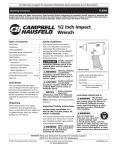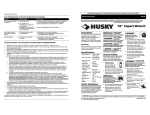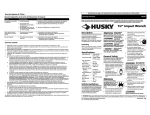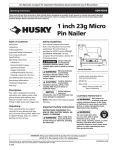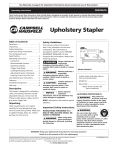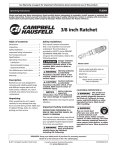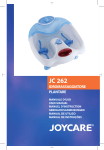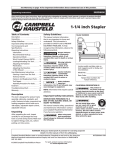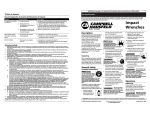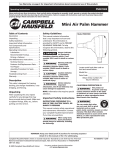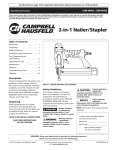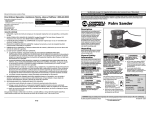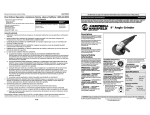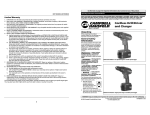Download Campbell Hausfeld TL050289 Operating instructions
Transcript
See Warranty on page 8 for important information about commercial use of this product. TL050289 Operating Instructions Please read and save these instructions. Read carefully before attempting to assemble, install, operate or maintain the product described. Protect yourself and others by observing all safety information. Failure to comply with instructions could result in personal injury and/or property damage! Retain instructions for future reference. 1/2 inch Impact Wrench Register your product online now! http://www.chpower.net/reg Table of Contents Safety Guidelines Description . . . . . . . . . . . . . . . . . . . . . . 1 This manual contains information that is very important to know and understand. This information is provided for SAFETY and to PREVENT EQUIPMENT PROBLEMS. To help recognize this information, observe the following symbols. Unpacking . . . . . . . . . . . . . . . . . . . . . . 1 Safety Guidelines . . . . . . . . . . . . . . . . . 1 Important Safety Information . . . . . . . 1 Tool Components and Specifications . . . . . . . . . . . . . . . . . . . . 2 Operating Instructions . . . . . . . . . . . . . 4 Regulator Operation . . . . . . . . . . . . 5 Danger indicates an imminently hazardous situation which, if not avoided, WILL result in death or serious injury. Speed Adjustment . . . . . . . . . . . . . . 5 Lubrication . . . . . . . . . . . . . . . . . . . . 4 Recommended Hookup . . . . . . . . . . 5 User-Maintenance Instructions . . . . . . 6 Troubleshooting Charts . . . . . . 6 and 7 Warranty . . . . . . . . . . . . . . . . . . . . . . . . 8 Warning indicates a potentially hazardous situation which, if not avoided, COULD result in death or serious injury. Description This is a rocking dog type impact wrench designed for DIY projects and general purpose applications such as maintenance, car repair, and lawn and garden equipment. Not intended for assembly line applications or heavy duty usage. Caution indicates a potentially hazardous situation which, if not avoided, MAY result in minor or moderate injury. Notice indicates important information, that if not followed, may cause damage to equipment. After unpacking the unit, inspect carefully for any damage that may have occurred during transit. Make sure to tighten fittings, bolts, etc., before putting unit into service. Locate model and date code on tool and record below: Model No.: _____________________ Date Code: _____________________ Retain these numbers for future reference. NOTE: Information that requires special attention. Unpacking Model TL050289 Important Safety Instructions INSTRUCTIONS PERTAINING TO A RISK OF FIRE, ELECTRIC SHOCK, OR INJURY TO PERSONS This manual contains safety, operational and maintenance information. Contact your Campbell Hausfeld representative if you have any questions. When using tools, basic precautions should always be followed, including the following: California proposition 65 This product or its power cord may contain chemicals known to the State of California to cause cancer and birth defects or other reproductive harm. Wash hands after handling. You can create dust when you cut, sand, drill or grind materials such as wood, paint, metal, concrete, cement, or other masonry. This dust often contains chemicals known to cause cancer, birth defects, or other reproductive harm. Wear protective gear. REMINDER: Keep your dated proof of purchase for warranty purposes! Attach it to this manual or file it for safekeeping. © 2012 Campbell Hausfeld / Scott Fetzer For parts, product & service information visit www.chpower.com IN737400AV 1/12 Operating Instructions Important Safety Instructions (Continued) General a. To reduce the risks of electric shock, fire, and injury to persons, read all the instructions before using the tool. c. Keep bystanders, children, and visitors away while operating the tool. Distractions are able to result in the loss of control of the tool. Personal Safety b. Be thoroughly familiar with the controls and the proper use of the equipment. Follow all instructions. Contact your Campbell Hausfeld representative if you have any questions. a. Stay alert. Watch what you are doing and use common sense when operating the tool. Do not use the tool while tired or under the influence of drugs, alcohol, or medication. A moment of inattention while operating the tool increases the risk of injury to persons. c. Only persons well acquainted with these rules of safe operation should be allowed to use the unit. Read and understand tool labels and manual. Failure to follow warnings, dangers, and cautions could result in DEATH or SERIOUS INJURY. b. Dress properly. Do not wear loose clothing or jewelry. Contain long hair. Keep hair, clothing, and gloves away from moving parts. Loose clothes, jewelry, or long hair increases the risk of injury to persons as a result of being caught in moving parts. Work Area c. Avoid unintentional starting. Be sure the switch is off before connecting to the air supply. Do not carry the tool with your finger on the switch or connect the tool to the air supply with the switch on. a. Keep the work area clean and well lighted. Cluttered benches and dark areas increase the risks of electric shock, fire, and injury to persons. b. Do not operate the tool in explosive atmospheres, such as in the presence of flammable liquids, gases, or dust. The tool is able to create sparks resulting in the ignition of the dust or fumes. d. Remove adjusting keys or wrenches before turning on the tool. A key or wrench attached to a rotating part of the tool may result in personal injury. e. Do not overreach. Keep proper footing and balance at all times. Proper footing and balance enables better control of the tool in unexpected situations. f. Use safety equipment. A dust mask, non-skid safety shoes and a hard hat must be used for the applicable conditions. g. Always wear eye protection. h. Always wear hearing protection when using the tool. Prolonged exposure to high intensity noise is able to cause hearing loss. i. Do not attach the hose or tool to your body. Attach the hose to the structure to reduce the risk of loss of balance if the hose shifts. Always remain in a firmly balanced position when using or handling the tool. Avoid long extended periods of work with the tool. Stop using the tool if you feel pain in hands or arms. j. Hold tool by insulated gripping surface when performing an operation where the tool may contact hidden wiring. Contacting a “live” wire will make exposed metal parts of the tool “live” and shock the operator. Tool Components and Specifications Avg. SCFM & psi . . . . . . . . . 5.1 @ 90 psig (20% usage) Anvil Continuous SCFM . . . . . . . 25.4 @ 90 psig (100% usage) Max. Operating Pressure . . . . . . . . . . . . . . . . . . . . . 90 psig Minimum Rated RPM . . . . . . . . . . . . 6000 Max Torque . . . . . . . . . . . . . . . . . 250 ft.lb Forward / Reverse Button Working Torque . . . . . . . . . . . 60-200 ft.lb Impact Mechanism Type . . . . . . . . . . . . . . . . . . . Rocking Dog Trigger Bolt Capacity . . . . . . . . . . . . . . . . . 1/2 inch Air Inlet . . . . . . . . . 1/4 inch NPT (Female) Min Hose Size . . . . . . . . . . . . . . . . 3/8 inch Regulator Drive . . . . . . . . . . . . . . . . . . . . 1/2 inch sq. Weight . . . . . . . . . . . . . . . . . . . . . . . . 5 lbs. Air Inlet www.chpower.com 2 TL050289 Important Safety Instructions (Continued) k. Avoid body contact with grounded surfaces such as pipes, radiators, ranges, and refrigerators. There is an increased risk of electric shock if your body is grounded. l. Explore the workpiece to avoid contact with hidden wiring. Thoroughly investigate the workpiece for possible hidden wiring before performing work. Contact with live wiring will shock the operator. m. Never point an air tool at oneself or any other person. Serious injury could occur. n. Do not put hands near or under moving parts. Tool Use and Care a. Use clamps or another practical way to secure and support the workpiece to a stable platform. Holding the work by hand or against the body is unstable and is able to lead to loss of control. b. Do not force the tool. Use the correct tool for the application. The correct tool will do the job better and safer at the rate for which the tool is designed. c. Do not use the tool if the switch does not turn the tool on or off. Any tool that cannot be controlled with the switch is dangerous and must be repaired. Disconnect the tool from the air source before making adjustments, doing tool maintenance, clearing jams, leaving work area,loading, or unloading the tool. Such precautionary measures reduce the risk of injury to persons. d. e. Store the tool when it is idle out of reach of children and other untrained persons. A tool is dangerous in the hands of untrained users. f. Maintain the tool with care. Keep a cutting tool sharp and clean. A properly maintained tool, with sharp cutting edges reduces the risk of binding and is easier to control. g. Check for misalignment or binding of moving parts, breakage of parts, and any other condition that affects the tool’s operation. If damaged, have the tool serviced before using. Many accidents are caused by poorly maintained tools. There is a risk of bursting if the tool is damaged. h. Use only accessories that are identified by the manufacturer for the specific tool model. Use of an accessory not intended for use with the specific tool model increases the risk of injury to persons. i. Selecting an appropriate tool actuation system, taking into consideration the work application for which the tool is used. Never use gasoline or other flammable liquids to clean the tool. Never use the tool in the presence of flammable liquids or gases. Vapors could ignite by a spark and cause an explosion which will result in death or serious personal injury. Do not exceed maximum operating pressure of the air tool (90 psi). The air tool could explode and result in death or serious personal injury. Do not use hand tool sockets. Use impact quality sockets only. Hand tool sockets are “glass-hard” and will shatter and can cause serious personal injury if used with air tools. j. Never trigger the tool when not applied to a work object. Attachments must be securely attached. Loose attachments can cause serious injury. Release all pressure from the system before attempting to install, service, relocate or perform any maintenance. k. Keep all nuts, bolts and screws tight and ensure equipment is in safe working condition. Always disconnect the tool from the power source when unattended, performing any maintenance or repair, clearing a jam, or moving the tool to a new location. Always fit tool with a fitting or hose coupling on or near the tool in such a manner that all compressed air in the tool is discharged at the time the fitting or hose coupling is disconnected. Do not use a check valve or any other fitting which allows air to remain in the tool. Death or serious personal injury could occur. Never carry the tool by the air hose or pull the hose to move the tool or a compressor. Keep hoses away from heat, oil and sharp edges. Replace any hose that is damaged, weak or worn. Personal injury or tool damage could occur. WARNING Do not operate or allow anyone else to operate the tool if any warnings or warning labels are not legible. Warnings or warning labels are located on the tool magazine and body. ! Do not drop or throw the tool. Dropping or throwing the tool can result in damage that will make the tool unusable or unsafe. If the tool has been dropped or thrown, examine the tool closely for bent, cracked or broken parts and air leaks. STOP and repair before using or serious injury could occur. Clean and check all air supply hoses and fittings before connecting the tool to an air supply. Replace any damaged or worn hoses or fittings. Tool performance or durability may be reduced. Service a. Tool service must be performed only by qualified repair personnel. b. When servicing a tool, use only identical replacement parts. Use only authorized parts. c. Use only the lubricants supplied with the tool or specified by the manufacturer. www.chpower.com 3 Operating Instructions Important Safety Instructions (Continued) Do not make any modifications to the tool without first obtaining written approval from Campbell Hausfeld. Do not use the tool if any shields or guards are removed or altered. Do not use the tool as a hammer. Personal injury or tool damage may occur. Air Source a. Never connect to an air source that is capable of exceeding 200 psi. Over pressurizing the tool is able to result in bursting, abnormal operation, breakage of the tool or serious injury to persons. Use only clean, dry, regulated compressed air at the rated pressure or within the rated pressure range as marked on the tool. Always verify prior to using the tool that the air source has been adjusted to the rated air pressure or within the rated air-pressure range. b. Never use oxygen, carbon dioxide, combustible gases or any bottled gas as an air source for the tool. Such gases are capable of explosion and serious injury to persons. Do not use any O CO type of reactive gases, including, but not limited to, oxygen and combustible gases, as a power source. Use filtered, lubricated, regulated compressed air only. Use of a reactive gas instead of compressed air may cause the tool to explode which will cause death or serious personal injury. 2 Use only a pressure-regulated compressed air source 90 psi to limit the air pressure supplied to the tool. The regulated pressure must not exceed 90 psi. If the regulator fails, the pressure delivered to the tool must not exceed 200 psi. The tool could explode which will cause death or serious personal injury. Operating Instructions Lubrication Proper lubrication is the owner’s responsibility. Failure to lubricate the air tool properly will dramatically shorten the life of the tool and will void the warranty. This impact wrench requires lubrication before the initial use and before and after each additional use. Impact wrenches require lubrication throughout the life of the tool and must be lubricated in two separate areas: the air motor and the impact mechanism. Air tool oil is recommended because this oil cleans, lubricates and inhibits rust all in one step. Air Motor Lubrication The motor must be lubricated daily. An air motor cannot be oiled too often. Disconnect the impact wrench from the air supply before lubricating. 1. Disconnect the impact wrench from the air supply. 2. Turn the impact wrench upside down. 3. While pulling the trigger, squeeze approximately a 1/4 oz. of airtool oil in the air inlet. Then, push the forward and reverse button in both directions. After an air tool has been lubricated, oil will discharge through the exhaust port during the first few seconds of operation. Thus, THE EXHAUST PORT MUST BE COVERED WITH A TOWEL before applying air pressure. FAILURE TO COVER THE EXHAUST PORT CAN RESULT IN SERIOUS INJURY. c. Do not exceed any pressure rating of any component in the system. Save These Instructions Do Not Discard www.chpower.com 4 4. Connect the impact wrench to the air supply and cover the exhaust port with a towel. Run the impact wrench in both the forward and reverse directions for 20 to 30 seconds. Oil will discharge from the exhaust port when air pressure is applied. Impact Mechanism Lubrication Lubricate the impact mechanism monthly. Disconnect the impact wrench from the air supply before lubricating. 1. Disconnect the impact wrench from the air supply. 2. Remove the slotted screw or allen head screw from the oil port hole. 3. Squeeze approximately 1 oz. of air tool oil in the oil port hole. Replace the screw. 4. Reconnect the air supply to the impact wrench and run for 20 to 30 seconds. Lubricate the entire impact mechanism by rotating the tool upside down and sideways while running the tool. 5. Remove the screw and hold the oil port hole over a suitable container to allow excess oil to drain. Sometimes triggering the tool when dumping the oils helps to force out the excess oil. 6. If the oil is dirty, repeat the procedure above until the oil comes out clear. Install the screw and tighten. The residual oil remaining in the impact mechanism chamber is all that is needed for proper lubrication. TL050289 Operating Instructions (Continued) Recommended Hookup The illustration below shows the recommended hookup for the tool. 60 psi 1. The air compressor Min. must be able to 90 psi maintain a minimum Max. of 60 psi when the tool is being used. An inadequate air supply can cause a loss of power and inconsistent driving. 2. An oiler can be used to provide oil circulation through the tool. A filter can be used to remove liquid and solid impurities which can rust or “gum up” internal parts of the tool. 3. Always use air supply hoses with a minimum working pressure rating equal to or greater than the pressure from the power source if a regulator fails, or 200 psi, whichever is greater. Use 1/4 inch air hose for runs up to 50 feet. Use 3/8 inch air hoses for 50 foot run or longer. 200 psi or greater Regulator Operation This impact wrench is equipped with several power (speed) settings. Use the switch on the rear of the tool to select the proper setting before operating tool. The tool has 4 power(speed) settings on the regulator, and forward and reverse settings on the valve stem above the trigger. Do not change settings while tool is running. SPEED ADJUSTMENT Using fittings or air hoses which are too small can create a pressure drop and reduce the power of the tool. For 3/8, 1/2 and 3/4 inch impact wrenches use 3/8 inch (I.D.) fittings with 1/4 inch NPT threads. Most compressors are shipped with a short, 1/4 inch I.D. hose. For proper performance and more convenience, use a 3/8 inch I.D. hose. Hoses longer than 50 feet should have a 1/2 inch I.D. An impact wrench should never be used to set torque. Use a torque wrench to set the torque. To remove lugs or bolts, set the regulator to the maximum setting. When installing, always use a torque wrench to attain the proper torque of the lugs or bolts. Never carry a tool by the hose or pull the hose to move the tool or a compressor. Keep hoses away from heat, oil and sharp edges. Replace any hose that is damaged, weak or worn. When reassembling be careful not to overtighten. Bolts may fail or cause a hazardous condition. Be sure to set the regulator to the minimum setting then use a torque wrench to set torque. NOTE: It is not recommended to install a quick coupler between the tool and the whip hose. 3/8 inch I.D. 4. Use a pressure regulator on the compressor, with an operating pressure of 0 psi - 125 psi. A pressure regulator is required to control the operating pressure of the tool between 60 psi and 90 psi. Recommended Hookup Quick Plug Quick Coupler Quick Plug (Optional) Air Hose Regulator Quick Coupler (Optional) Lubricator Filter www.chpower.com 5 Operating Instructions User-Maintenance Instructions Technical Service Please call our Tool Hotline at 1-800543-6400 with any questions regarding the operation or repair of this tool or for additional copies of this manual. Replacement Parts Information For information regarding where to order replacement parts, call toll free 1-800-543-6400. Please provide the following information: • Model number • Stamped-in code • Part number and description Tool Repair Storage Only qualified personnel should repair the tool and they should use genuine Campbell Hausfeld replacement parts and accessories, or parts and accessories which perform equivalently. The impact wrench must be lubricated before storing. Follow the air motor lubrication instructions with an exception to step 4. Only run the impact wrench for 2 to 3 seconds instead of 20 to 30 seconds because more oil needs to remain in the impact wrench when storing. The tool should be stored in a cool dry place. Assembly Procedure For Seals When repairing a tool, the internal parts must be cleaned and lubricated. Parker O-lube or equivalent must be used on all o-rings. Each o-ring must be coated with O-lube before assembling. A small amount of oil must be used on all moving surfaces and pivots. After reassembling, a few drops of 30W non-detergent oil or equivalent, must be added through the air line before testing. Troubleshooting Chart Stop using tool immediately if any of the following problems occur. Serious personal injury could occur. Any repairs or replacements must be done by a Qualified Service Person or Authorized Service Center. Symptom Tool runs slowly or will not operate Possible Cause(s) Corrective Action 1. Grit or gum in tool 1. Flush the tool with air tool oil, gum solvent, or an equal mixture of SAE 10 motor oil and kerosene. If air tool oil is not used, lubricate the tool after cleaning 2. No oil in tool 2. Lubricate the tool according to the lubrication instructions in this manual 3. Low air pressure 3. a. Adjust the regulator on the tool to the maximum setting b. Adjust the compressor regulator to tool maximum while the tool is running free 4. Air hose leaks* 4. Tighten and seal hose fittings if leaks are found 5. Pressure drops 5. a. Be sure the hose is the proper size. Long hoses or tools using large volumes of air may require a hose with an I.D. of 1/2 inch or larger depending on the total length of the hose 6. Worn ball bearing in motor www.chpower.com 6 b. Do not use a multiple number of hoses connected together with quick connect fittings. This causes additional pressure drops and reduces the tool power. Directly connect the hoses together 6. Remove and inspect bearing for rust, dirt and grit or worn race. Replace or clean and regrease bearing with bearing grease TL050289 Impact Mechanism Troubleshooting Guide Symptom Possible Cause(s) Corrective Action Moisture blowing out of tool 1. Water in tank 1. Drain tank. (See air compressor manual). Oil tool and run until no water is evident. Oil tool again and run 1-2 seconds 2. Water in the air lines/hoses Impacts slowly or will not impact Impacts rapidly but will not remove bolts 2. a. Install a water separator/filter. NOTE: Separators only work properly when the air passing through the separator is cool. Locate the separator/filter as far as possible from the compressor b. Install an air dryer c. If the original separator will not separate all the water from the air, install a belt air filter 1. Lack of lubrication 1. Lubricate the air motor and the impact mechanism. (See Lubrication section of this manual) 2. Tool regulator set in wrong position 2. Adjust the regulator on the tool to the maximum setting 3. In-line regulator or compressor regulator set too low 3. Adjust regulators in the air system 1. Worn impact mechanism 1. a. Replace worn impact mechanism components Does not impact 1. Broken impact mechanism b. Return impact wrench to Authorized Service Center for repair 1. a. Replace broken impact mechanism components b. Return impact wrench to an Authorized Service Center for repair www.chpower.com 7 Operating Instructions Limited Warranty 1. DURATION: From the date of purchase by the original purchaser as follows: one (1) year. 2. WHO GIVES THIS WARRANTY (WARRANTOR): Campbell Hausfeld / Scott Fetzer Company, 100 Production Drive, Harrison, Ohio, 45030, Telephone: (800) 543-6400. 3. WHO RECEIVES THIS WARRANTY (PURCHASER): The original purchaser (other than for purposes of resale) of the Campbell Hausfeld product. 4. WHAT PRODUCTS ARE COVERED BY THIS WARRANTY: This Campbell Hausfeld impact wrench. 5. WHAT IS COVERED UNDER THIS WARRANTY: Substantial defects in material and workmanship which occur within the duration of the warranty period with the exceptions below. 6. WHAT IS NOT COVERED UNDER THIS WARRANTY: A. Implied warranties, including those of merchantability and FITNESS FOR A PARTICULAR PURPOSE ARE LIMITED FROM THE DATE OF ORIGINAL PURCHASE AS STATED IN THE DURATION. If this product is used for commercial, industrial or rental purposes, the warranty will apply for ninety (90) days from the date of purchase. Some States do not allow limitation on how long an implied warranty lasts, so the above limitations may not apply to you. B. ANY INCIDENTAL, INDIRECT, OR CONSEQUENTIAL LOSS, DAMAGE, OR EXPENSE THAT MAY RESULT FROM ANY DEFECT, FAILURE, OR MALFUNCTION OF THE CAMPBELL HAUSFELD PRODUCT. Some States do not allow the exclusion or limitation of incidental or consequential damages, so the above limitation or exclusion may not apply to you. C. Any failure that results from an accident, purchaser’s abuse, neglect or failure to operate products in accordance with instructions provided in the owner’s manual(s) supplied with product. Accident, purchaser’s abuse, neglect or failure to operate products in accordance with instructions shall also include the removal or alteration of any safety devices. If such safety devices are removed or altered, this warranty is void. D. Normal adjustments which are explained in the owner’s manual(s) provided with the product. E. Items or service that are normally required to maintain the product, e.g. o-rings, springs, gaskets, packings or seals, lubricants, motor vanes, impact mechanism, or any other expendable part not specifically listed. These items will only be covered for ninety (90) days from date of original purchase. Underlined items are warranted for defects in material and workmanship only. 7. RESPONSIBILITIES OF WARRANTOR UNDER THIS WARRANTY: Repair or replace, at Warrantor’s option, products or components which are defective, have malfunctioned and/or failed to conform within the duration of the specific warranty period. 8. RESPONSIBILITIES OF PURCHASER UNDER THIS WARRANTY: A. Provide dated proof of purchase and maintenance records. B. Call Campbell Hausfeld (800-543-6400) to obtain your warranty service options. Freight costs must be borne by the purchaser. C. Use reasonable care in the operation and maintenance of the products as described in the owner’s manual(s). 9. WHEN WARRANTOR WILL PERFORM REPAIR OR REPLACEMENT UNDER THIS WARRANTY: Repair or replacement will be scheduled and serviced according to the normal work flow at the servicing location, and depending on the availability of replacement parts. This Limited Warranty applies in the United States, Canada and Mexico only and gives you specific legal rights. You may also have other rights which vary from state to state or country to country. www.chpower.com 8 Ver la Garantía en página 8-Sp para información importante sobre el uso comercial de este producto. TL050289 Manual de Instrucciones de Operación Por favor lea y guarde estas instrucciones. Léalas cuidadosamente antes de tratar de montar, instalar, operar o dar mantenimiento al producto aquí descrito. Protéjase usted mismo y a los demás observando toda la información de seguridad. ¡El no cumplir con las instrucciones puede ocasionar daños, tanto personales como a la propiedad! Guarde estas instrucciones para referencia en el futuro. Pistola de Impacto de 12,7 mm (1/2 pulg.) ¡Registre su producto en línea ahora mismo! http://www.chpower.net/reg Índice Medidas de Seguridad Descripción . . . . . . . . . . . . . . . . . . . . 1-Sp Desempaque . . . . . . . . . . . . . . . . . . 1-Sp Medidas de Seguridad . . . . . . . . . . . 1-Sp Instrucciones de Seguridad Importantes . . . . . . . . . . . . . . . . . . . 1-Sp Componentes y Especificaciones de la Herramienta . . . . . . . . . . . . . . 2-Sp Instrucciones de Funcionamiento . . 4-Sp Lubricacion . . . . . . . . . . . . . . . . . . 4-Sp Conexión Recomendada . . . . . . . . 5-Sp Funcionamiento del Regulador . . . . . . . . . . . . . . . . . . . 5-Sp Ajuste de Velocidad . . . . . . . . . . . 5-Sp Instrucciones de uso y Mantenimiento . . . . . . . . . . . . . . . . 6-Sp Guía de Diagnóstico de Averías . . . . . . . . . . . . . . . . . 6-Sp y 7-Sp Este manual contiene información que es muy importante que sepa y comprenda. Esta información se la suministramos como medida de SEGURIDAD y para EVITAR PROBLEMAS CON EL EQUIPO. Debe reconocer los siguientes símbolos. Garantía Limitada . . . . . . . . . . . . . . 8-Sp Descripción Esto es una pistola de impacto con mecanismo de empaque de retén oscilante diseñada para trabajos domésticos en general tales como trabajos de mantenimiento, reparación de automóviles, y reparación de equipos de jardinería. Esta herramienta no está diseñada para usarse en líneas de ensamblaje ni para trabajos pesados. Desempaque Al desempacar este producto, revíselo con cuidado para cerciorarse de que esté en perfecto estado. Cericiórese de apretar todas las conexiones, pernos, etc. antes de comenzar a utilizar la unidad. Ésto le indica que hay una situación inmediata que LE OCASIONARIA la muerte o heridas de gravedad. Ésto le indica que hay una situación que PODRIA ocasionarle la muerte o heridas de gravedad. Ésto le indica que hay una situación que PODRIA ocasionarle heridas no muy graves. Ésto le indica una información importante, que de no seguirla, le podría ocasionar daños al equipo. NOTA: Información que requiere atención especial. Instrucciones de Seguridad Importantes INSTRUCCIONES EN REFERENCIA AL PELIGRO DE INCENDIOS, CHOQUE ELÉCTRICO O LESIONES PERSONALES Este manual contiene información sobre seguridad, funcionamiento y mantenimiento. Póngase en contacto con su representante Campbell Hausfeld si tiene alguna pregunta. Cuando se usen herramientas, siempre se deberán seguir precauciones básicas, incluyendo las siguientes: Modelo TL050289 Localice el modelo y el código de fecha en la herramienta y regístrelo debajo: Modelo: _____________________ Código de fecha ______________ Guarde estos números para referencia futura. PROPOSICIÓN 65 DE CALIFORNIA Este producto, o su cordón eléctrico, puede contener productos químicos conocidos por el estado de California como causantes de cáncer y defectos de nacimiento u otros daños reproductivos. Lave sus manos después de usar. Cuando corta lija, taladra o pule materiales como por ejemplo madera, pintura, metal, hormigón, cemento, u otro tipo de mampostería se puede producir polvo. Con frecuencia este polvo contiene productos químicos que se conocen como causantes de cáncer, defectos congénitos u otros daños reproductivos. Use equipo de protección. RECORDATORIO: ¡Guarde su comprobante de compra con fecha para fines de la garantía! Adjúntela a este manual o archívela en lugar seguro. © 2012 Campbell Hausfeld / Scott Fetzer 1-Sp IN737400AV 1/12 Manual de Instrucciones de Operación Instrucciones de Seguridad Importantes (Continúa) General a. Para reducir el riesgo de choque eléctrico, incendio y lesiones personales, lea todas las instrucciones antes de usar la herramienta. b. Familiarísece con los controles y el uso adecuado del equipo. Siga todas las instrucciones. Póngase en contacto con su representante Campbell Hausfeld si tiene alguna pregunta. c. Sólo se les debe permitir usar esta unidad a aquellas personas bien familiarizadas con estas reglas de manejo seguro. Lea y comprenda las etiquetas y el manual de la herramienta. Si no respeta las advertencias, los riesgos y las recomendaciones, eso podría resultar en la MUERTE o en LESIONES GRAVES. Área de trabajo a. Mantenga el área de trabajo limpia y bien iluminada. Los bancos desordenados y las áreas oscuras aumentan el riesgo de choque eléctrico, incendio y lesiones personales. b. No haga funcionar la herramienta en entornos explosivos, como por ejemplo cuando haya polvo, líquidos o gases inflamables. La herramienta puede crear chispas y provocar la ignición de polvo o vapores. c. Mantenga alejados a los observadores, niños y visitantes mientras hace funcionar la herramienta. Las distracciones pueden dar como resultado la pérdida del control de la herramienta. SEGURIDAD PERSONAL a. Manténgase alerta. Mire lo que está haciendo y use el sentido común cuando haga funcionar la herramienta. No use la herramienta si está cansado o bajo la influencia de drogas, alcohol o medicamentos. Un momento de desatención mientras hace funcionar la herramienta aumenta el riesgo de lesiones personales. b. Vístase adecuadamente. No use alhajas ni vestimenta suelta. Sujétese el cabello largo. Mantenga el cabello, vestimenta y guantes alejados de las piezas móviles. La vestimenta suelta, las alhajas o el cabello largo aumentan el riesgo de lesiones personales como resultado de quedar atrapados en las piezas móviles. c. Evite que se encienda accidentalmente. Asegúrese de que el interruptor esté en la posición de apagado antes de conectar el suministro de aire. No lleve la herramienta con su dedo sobre el interruptor ni conecte la herramienta al suministro de aire con el interruptor en la posición de encendido. d. Quite las llaves de ajuste o antes de encender la herramienta. Una conectada a una pieza giratoria de la herramienta puede provocar lesiones personales. e. No intente alcanzar lugares alejados. Mantenga un buen soporte y equilibrio en todo momento. Un soporte y equilibrio adecuados permiten un mejor control de la herramienta en situaciones inesperadas. f. Use equipo de seguridad. Se debe usar una mascara para polvo, calzado de seguridad antideslizante y casco para las condiciones que se apliquen. g. Siempre use protección para los ojos. h. Use siempre una protección para el oído cuando use la herramienta. La exposición prolongada a ruido de alta intensidad puede causar pérdida de audición. i. No ate la manguera ni la herramienta a su cuerpo. Adjunte la manguera a la estructura para reducir el riesgo de pérdida de equilibrio si la manguera se cambia de posición. Componentes y Especificaciones de la Herramienta m /min promedio . . . . . . 0,14 @ 6,21 bar y bar (20% de uso) 3 Yunque m /min continuo . . . . . . . 0,72 @ 6,21 bar (100% de uso) 3 Máx. presión operativa . . . . . . . 6,21 bar qqqqqqqqq Torque Máx . . . . . . . . . . . . . . . . 34,6 kg m Torque de trabajo . . . . . . . . . . . 8,3 kg m 27,7 kg m Botón para cambiar el sentido Tipo de mecanismo Tipo retén de impacto . . . . . . . . . . . . . . . . . oscilante Gatillo Capacidad del perno . 12,7mm (1/2 Inch) Entrada de aire . . . . . . . 6,4mm (1/4 Inch) NPT (Hembra) Tamaño Mín. de la manguera . . . . . . . . . 9,5mm (3/8 Inch) Portaherramientas . . . 12,7mm (1/2 Inch) Sq Regulador Peso . . . . . . . . . . . . . . . . . . . . . . . . . . 2,3kg 2-Sp Entrada de aire TL050289 Instrucciones de Seguridad Importantes (Continúa) Siempre colóquese en una posición firme y balanceada para usar o manipular la herramienta. Evite trabajar con esta herramienta por largos periodos. Deje de usar la herramienta si siente dolor en las manos o en los brazos. j. Sostenga la herramienta por la superficie de sujeción aislada cuando realice una operación en la que la herramienta pueda entrar en contacto con un cableado oculto. Al entrar en contacto con un cable de corriente las piezas metálicas de la herramienta conducirán la electricidad y el usuario recibirá un choque eléctrico. k. Evite el contacto corporal con las superficies conectadas a tierra, tales como tuberías, radiadores, cocinas eléctricas o refrigeradores. Existe un mayor riesgo de choque eléctrico si su cuerpo está conectado a tierra. l. Examine la pieza de trabajo para evitar entrar en contacto con un cableado oculto. Revise bien la pieza de trabajo para verificar posibles cableados ocultos antes de realizar el trabajo. El contacto con un cable bajo tensión eléctrica causará que el usuario reciba un choque eléctrico. m. Nunca apunte una herramienta neumática hacia usted ni hacia otra persona. Pueden ocurrir lesiones graves. n. No acerque las manos a las piezas móviles ni las coloque debajo de ellas. Uso y cuidado de la herramienta a. Use sujetadores u otra manera práctica de asegurar y apoyar la pieza de trabajo a una plataforma estable. Sostener el trabajo con la mano o contra el cuerpo es algo inestable y puede producir la pérdida de control. b. No fuerce la herramienta. Use la herramienta correcta para la aplicación. La herramienta correcta hará el trabajo mejor y en forma más segura a la velocidad para la cual fue diseñada. c. No use la herramienta si el interruptor no la enciende o no la apaga. Cualquier herramienta que no pueda ser controlada con el interruptor es peligrosa y debe repararse. d. Desconecte la herramienta del suministro de aire antes de hacer cualquier ajuste, realizar el mantenimiento de la herramienta, eliminar obstrucciones, dejar el área de trabajo, cargar o descargar la herramienta. Estas medidas de precaución reducen el riesgo de lesiones personales. e. Cuando no esté en uso, guarde la herramienta fuera del alcance de los niños y otras personas no capacitadas. Una herramienta es peligrosa cuando está en manos de usuarios inexpertos. f. Cuide su herramienta. Mantenga una herramienta para cortar afilada y limpia. Una herramienta mantenida adecuadamente con bordes de corte afilados reduce el riesgo de atascarse y es más fácil de controlar. g. Verifique que las piezas móviles no estén desaliñadas ni adheridas, que no haya piezas rotas y que no exista ningún otro problema que afecten el funcionamiento de la herramienta. Si está dañada, haga que le realicen un servicio a la herramienta antes de usarla. Muchos accidentes son causados por herramientas que no tienen un mantenimiento adecuado. Si la herramienta sufre un daño, hay riesgo de explosión. h. Use únicamente los accesorios que están identificados por el fabricante para el modelo de herramienta específico. El uso de un accesorio no diseñado para usarse con el modelo de herramienta específico aumenta el riesgo de lesiones personales. i. Seleccionar un sistema de activación de la herramienta adecuado, tomando en cuenta la aplicación de trabajo para la cual se usa la herramienta. Nunca limpie la herramienta con gasolina o ningún otro líquido inflamable. Nunca use la herramienta en la cercanías de líquidos o gases inflamables. Una chispa podría encender los vapores y ocasionar una explosión que podría ocasionarle la muerte o heridas graves. 3-Sp Nunca exceda la capacidad máxima de presión de la herramienta neumática (6,3 bars). La herramienta neumática podría explotar y ocasionarle la muerte o heridas graves. No use dados para herramientas manuales. Sólo use dados para llaves de impacto. Los dados para herramientas manuales son “tan fuertes como el vidrio” y se romperán ocasionándole heridas graves. j. Nunca oprima el gatillo a menos que la herramienta esté apuntada al área de trabajo. Cerciórese de que los accesorios estén bien apretados. De lo contrario, podrían ocasionarle heridas graves. Libere toda la presión del sistema antes de tratar de instalar, darle servicio, reubicar o darle mantenimiento. k. Mantenga todas las tuercas, tornillos y pernos bien apretados y cerciórese de que el equipo esté en buenas condiciones de funcionamiento. Desconecte siempre la herramienta de la fuente de energía cuando no la esté atendiendo, cuando le esté realizando mantenimiento o reparaciones, desobstruyéndola o moviéndola a un nuevo sitio. Siempre ajuste la herramienta con un conector o acoplador de mangueras colocado en o cerca de la herramienta de un modo tal que se descargue todo el aire comprimido en la herramienta en el momento en que se desconecte el conector o acoplador. No use una válvula de chequeo o ninguna conexión que permita que el aire permanezca en la herramienta. Se puede producir la muerte o lesiones personales graves. Nunca cargue la herramienta por la manguera de aire ni hale la manguera para mover la herramienta o el compresor de aire. Mantenga las mangueras alejadas del calor, aceite y objetos puntiagudos. Reemplace cualquier manguera que esté dañada, débil o desgastada. Ésto podría ocasionar heridas o daños a la herramienta Manual de Instrucciones de Operación Instrucciones de seguridad importantes (Continúa) ! ADVERTENCIA No opere la herramienta ni permita que otros la operen si las etiquetas de advertencia están ilegibles. Éstas se encuentran en el cargador o el cuerpo de la herramienta. No deje que la herramienta se caiga ni la tire. Ésto podría dañarla o convertirla en algo peligroso de usar. En caso de que la herramienta se haya caído o la hayan tirado, revísela con cuidado a ver si está doblada o rota, si tiene alguna pieza dañada o tiene fugas de aire. DEJE de trabajar y repárela antes de usarla o podría ocasionarle heridas graves. Limpie y chequee todas las mangueras de suministro de aire y conexiones antes de conectar la herramienta al compresor. Reemplace las mangueras y conexiones que estén dañadas o desgastadas. El rendimiento de la herramienta o su durabilidad podrían reducirse. Servicio a. El servicio de la herramienta debe ser realizado sólo por personal de reparaciones calificado. b. Al realizarle un servicio a la herramienta, utilice únicamente piezas de repuesto idénticas. Use sólo piezas autorizadas. c. Use sólo los lubricantes que el fabricante proporciona con la herramienta. No haga ninguna modificación a la herramienta sin obtener primero la aprobación por escrito de Campbell Hausfeld. No use la herramienta si le faltan alguna de las tapas protectoras o si éstas han sido modificadas. No use la herramienta como un martillo. Se pueden producir lesiones personales o daños a la herramienta. Suministro de aire a. Nunca conecte a un suministro de aire capaz de exceder las 13,79 bar. Someter la herramienta a presión excesiva puede resultar en una explosión, funcionamiento anormal, daños a la herramienta o graves lesiones personales. Use sólo aire comprimido limpio, seco y regulado a la presión de funcionamiento o dentro del rango de presiones indicado en la herramienta. Antes de usar la herramienta, verifique siempre que el suministro de aire haya sido regulado a la presión de funcionamiento o esté dentro del rango de presiones indicadas. b. No use nunca oxígeno, dióxido de carbono, gases combustibles o ningún gas en botellas como suministro de aire para la herramienta. Tales gases puede explotar y causar graves lesiones personales. No use ningún O CO tipo de gas reactivo, incluyendo, pero no limitado a, oxígeno y gases combustibles, como fuente de energía. Use sólo aire comprimido filtrado, lubricado y regulado. El uso de un gas reactivo en vez de aire comprimido puede provocar que la herramienta explote, lo cual puede ocasionar la muerte o graves lesiones personales. Use solamente una fuente de aire comprimido de presión regulada para 6,21 bar limitar la presión de aire suministrada a la herramienta. La presión regulada no debe exceder los 6,21 bar. Si el regulador falla, la presión transmitida a la herramienta no debe exceder los 13,79 bar. La herramienta puede explotar, lo cual puede ocasionar la muerte o graves lesiones personales. c. Nunca exceda ninguna de las presiones máximas indicadas para los componentes del sistema. 2 GUARDE ESTAS INSTRUCCIONES – NO LAS DESECHE Instrucciones de funcionamiento Lubricacion La lubricación adecuada del equipo es la responsabilidad del propietario. El no lubricarlo adecuadamente reducirá drásticamente la duración de la herramienta y descontinuará la garantía. Esta llave de impacto REQUIERE lubricación ANTES de usarla por primera vez y DESPUES de cada uso adicional. 4-Sp Las llaves de impacto requieren lubricación constantemente y deben ser lubricadas en dos áreas diferentes: el motor neumáticoy el mecanismo de impacto. Se recomienda el uso de aceite para herramientas neumáticas porque limpia, lubrica y previene el óxido al mismo tiempo. Lubricacion del motor neumatico El motor debe ser lubricado diariamente. Este tipo de motor nunca será lubricado en exceso. Desconecte la llave de impacto de la fuente de aire antes de lubricarla. 1. Desconecte la llave de impacto de la fuente de aire. 2. Voltéela de modo que la entrada de aire esté hacia arriba. 3. Mientras oprime el gatillo, apriete cerca de un cuarto de onza de aceite para herramientas neumáticas en el orificio de entrada de aire. Después, mueva el botón para cambiar el sentido en ambas direcciones. Despuésque una herramienta neumática ha sido lubricada expulsará aceite por el orificio de salida durante los primeros segundos de funcionamiento. Por lo tanto, DEBERA CUBRIR EL ORIFICIO DE SALIDA CON UNA TOALLA antes de aplicar presión de aire. DE LO CONTRARIO, PODRIA OCASIONARLE HERIDAS GRAVES. 4. Conecte la llave de impacto a la fuente de aire y cubra el orificio de salida con una toalla. Haga funcionar la llave de impacto en ambas direcciones por unos 20 ó 30 segundos. Saldrá aceite por el orificio de salida al aplicarle presión de aire. Lubricacion del Mecanismo de Impacto Lubrique el mecanismo de impacto mensualmente. Desconecte la llave de impacto de la fuente de aire antes de lubricarla. 1. Desconecte la llave de impacto de la fuente de aire. 2. Saque el tornillo plano o tipo allen del orificio de lubricación. TL050289 Instrucciones de funcionamiento (Continúa) 3. Apriete cerca de una onza de aceite para herramientas neumáticas en el orificio para el aceite. Cóloquele el tornillo. 4. Reconecte la fuente de aire a la llave de impacto y déjela funcionar por 20 ó 30 segundos. Lubrique todo el mecanismo de impacto volteando la herramienta en todos los sentidos mientras que la herramienta esté funcionando. 5. Quítele el tornillo, sostenga la herramienta sobre un envase adecuado y drene el exceso de aceite. Algunas veces, oprimir el gatillo, cuando está vaciando el aceite, le ayuda a expulsar el exceso de aceite. 6. Si el aceite está sucio, repita el procedimiento anterior hasta que el aceite salga limpio. Coloque el tornillo y apriételo. El residuo de aceite que quede en la cámara del mecanismo de impacto es todo lo que se necesita para una lubricación adecuada. conexion Recomendada La ilustración de abajo le muestra la conexión recomendada para la herramienta. 1. El compresor de 4,14 bar Min. aire debe tener 6,21 bar la capacidad de Max. suministrar un mínimo de 4,14 bar cuando la herramienta esté en uso. Si el suministro de aire es inadecuado podría haber pérdida de potencia y falta de consistencia en el funcionamiento. 2. Puede utilizar un lubricador para lubricar la herramienta. Conexión Recomendada Conector rápido Igualmente, puede utilizar un filtro para remover las impurezas líquidas y sólidas que podrían oxidar u obstruir las partes internas de la herramienta. 3. Use siempre mangueras de suministro de aire, con una presión mínima de funcionamiento con clasificación igual o mayor que la presión de la fuente de energía si falla un regulador, o 13,79 bar, lo que sea mayor. Use mangueras de aire de 6,4 mm (1/4 pulg.) para distancias de hasta 15 m (50 pies). Use mangueras de aire de 0,95 mm (3/8 pulg.) para distancias de 15 m (50 pies) ó más. 13,79 bar o más 9,5 mm (3/8 in) I.D. 4. Use un regulador de presión (de 0 bar - 8,62 bar) en el compresor. Se necesita un regulador de presión para controlar la presión de operación de la herramienta entre 4,14 bar y 6,21 bar. Funcionamiento del Regulador Esta pistola de impacto viene equipada con varios ajustes de potencia (velocidad). Use el interruptor en la parte posterior de esta herramienta para seleccionar la velocidad apropiada antes de ponerla en uso. La herramienta tiene 4 ajustes de corriente (velocidades) en el regulador, y ajustes para adelante y atrás en el vástago de la válvula, arriba del gatillo. No cambie la velocidad mientras la herramienta está funcionando. AJUSTE DE VELOCIDAD Una llave de impacto nunca se debe usar para fijar el torque. Use una herramienta adecuada (torquímetro) para fijar el torque. Acoplador rápido Conector rápido (Opcional) Manguera de aire Acoplador rápido (Opcional) Lubricador 5-Sp Para sacar tuercas de llantas de automóviles o pernos, coloque el regular en lo máximo. Para colocarlos, siempre use un torquímetro para apretarlos adecuadamente. Cuando desee apretar pernos cerciórese de no apretarlos en exceso. Los pernos pueden romperse o crear una situación peligrosa. Cerciórese de fijar el regulador en lo mínimo y use un torquímetro para fijar el torque. NOTA: No es recomendable instalar un acoplador rápido entre la llave de impacto y la manguera flexible principal. El usar conexiones o mangueras de aire que sean muy pequeñas podría crear una baja de presión y reducir la potencia de la herramienta. Para las llaves de impacto de 10 mm (3/8 pulg.), 13 mm (1/2 pulg.) y 19 mm (3/4 pulg.) se recomienda el uso de conexiones de 10 mm (3/8 pulg.) de diámetro interno con roscas de 6,4 mm (1/4 pulg.) NPT. La mayoría de los compresores se envían con una manguera corta de 6,4 mm (1/4 pulg.) de diámetro interno. Para un funcionamiento adecuado y para mayor conveniencia, use una manguera de 10 mm (3/8 pulg.) de diámetro interno. Las mangueras de más de 15,24 m (50 pies) de longitud deben tener un diámetro interno de 13 mm (1/2 pulg.). Nunca cargue una herramienta por la manguera o hale la manguera para mover la herramienta o un compresor. Mantenga las mangueras alejadas del calor, aceite o puntas afiladas, reemplace cualquier manguera que esté dañada, deteriorada o desgastada. Regulador Filtro Manual de Instrucciones de Operación Instrucciones de funcionamiento Assistência Técnica Para mayor información en relación al funcionamiento o reparación de este producto, comuníquese con el concesionario de Campbell Hausfeld más cercano a su domicilio. Información Sobre Piezas de Repuesto Para obtener información de como obtener piezas de repuesto en Estados Unidos, sírvase llamar al 1-800-5436400. En el exterior, comuníquese con el distribuidor de productos Campbell Hausfeld más cercano a su domicilio. • Número del modelo • Código estampado • Número de pieza y descripción Para reparar la herramienta La herramienta deberá ser reparada únicamente por personal calificado, y deberán usar piezas de repuesto y accesorios originales Campbell Hausfeld, o piezas y accesorios que funcionen de manera equivalente. Para colocarle los sellos Cada vez que repare una herramienta deberá limpiarle y lubricarle las partes internas. Le recomendamos que use Parker O-lube o un lubricante equivalente en todos los anillos en O. A cada anillo en O se le debe dar un baño de lubricante para anillos antes de instalarlos. Igualmente, deberá ponerle un poco de aceite a todas las piezas que se mueven y muñones. Finalmente, después de haberla ensamblado y antes de probar la herramienta deberá ponerle unas cuantas gotas de aceite sin detergente 30W u otro aceite similar, en las líneas de aire. Almacenaje La llave de impacto se debe lubricar antes de almacenarla. Siga las instrucciones de lubricación excepto el paso 4. Sólo déjela funcionar 2 ó 3 segundos en vez de 20 ó 30 segundos ya que debe almacenar la con más aceite en el mecanismo de impacto. La agrapadora debe guardarse en un lugar fresco y seco. Guía de Diagnóstico de Averías Deje de usar la grapadora inmediatamente si alguno de los si guientes problemas ocurre. Podría ocasionarle heridas graves. Cualquier reparación o reemplazo de piezas los debe hacer un técnico calificado personal de un centro autorizado de servicio. Problema La herramienta funciona lentamente o no funciona Causa Solución 1. Hay acumulación de arenillas o goma 1. Enjuague la herramienta con aceite para herramientas neumáticas, diluyente de gomas, o una mezcla de partes iguales de aceite de motor SAE 10 y querosene. Si no se usa aceite para herramientas, lubrique la herramienta después de la limpieza. 2. La herramienta no tiene aceite 2. Lubrique la herramienta según las instrucciones de lubricación 3. La presión de aire es muy baja 3. a. Aumente la presión del regulador a lo máximo b. Aumente la presión del compresor a lo máximo mientras la herramienta funciona libremente 4. Hay una fuga de aire en las mangueras 4. De haber fugas en las mangueras apriete bien las conecciones 5. Ocurre una baja de presión 5. a. Cerciórese de que la manguera sea del tamaño adecuado. Las mangueras largas o herramientas que estén usando grandes volumenes de aire tal vez necesiten una manguera con un diámetro interno de 13mm (1/2 inch) o más según la longitud total de la manguera Nunca conecte varias mangueras con conectores rápidos. Ésto ocasiona bajas de presión adicionales y reduce la potencia. Conecte las mangueras directamente 6. Uno de los baleros del motor está desgastado 6-Sp b. 6. Saque los baleros y revíselos a ver si están oxidados, tienen impurezas o los anillos están desgastados. Reemplácelos o límpielos y lubríquelos con grasa para baleros TL050289 Guía de Diagnóstico de Averías (Continúa) Problema La herramienta expulsa residuos de agua El impacto es muy lento o no ocurre Causa Solución 1. Hay agua en el tanque 1. Drene el tanque (Lea el manual del compresor de aire). Póngale aceite a la herramienta y déjela funcionar hasta que no expulse más agua. Una vez más póngale aceite a la herramienta y déjela funcionar por unos 1 ó 2 segundos 2. Hay agua en las líneas de aire/ mangueras 2. a. Instale un filtro/ separador de agua. NOTA: Los separadores funcionan bien sólo cuando el aire que está circulando está frío. Coloque este filtro separador lo más lejos posible del compresor b. Instale un secador de aire c. Si el separador original no separa toda el agua del aire, instale un filtro de aire de correa. 1. Le falta lubricante 1. Lubrique el motor neumático y el mecanismo de impacto. (Lea las instrucciones de lubricación de este manual) 2. El regulador de la herramienta no está fijado correctamente 2. Ajuste el regulador de la herramienta a lo máximo 3. El regulador de la línea o el del compresor están fijados a un nivel muy bajo 3. Ajuste los reguladores en el sistema de aire Hace impacto rápidamente pero no saca los pernos 1. El mecanismo de impacto está desgastado 1. a. Reemplace el mecanismo de impacto No hace impacto 1. El mecanismo de impacto está roto 1. a. Reemplace el mecanismo de impacto 7-Sp b. Devuelva la llave de impacto al Centro de Servicio Autorizado para su reparación b. Devuelva la llave de impacto al Centro de Servicio Autorizado para su reparación Manual de Instrucciones de Operación Garantía Limitada 1 DURACION: A partir de la fecha de compra por el comprador original tal como se especifica a continuación: Un año. 2. QUIEN OTORGA ESTA GARANTIA (EL GARANTE: Campbell Hausfeld / The Scott Fetzer Company 100 Production Drive, Harrison, Ohio 45030 Teléfono: (800) 543-6400. 3. QUIEN RECIBE ESTA GARANTIA (EL COMPRADOR): El comprador original (que no sea un revendedor) del producto Campbell Hausfeld. 4. PRODUCTOS CUBIERTOS POR ESTA GARANTIA: Esta herramienta neumática Campbell Hausfeld. 5. COBERTURA DE LA GARANTIA: Defectos importantes en el material y la mano de obra que ocurran durante la duración del período de garantía con las excepciones que se mencionan a continuación. 6. LO QUE NO ESTA CUBIERTO POR ESTA GARANTIA: A. Las garantías implícitas, incluyendo aquellas de comercialidad E IDONEIDAD PARA FINES PARTICULARES, ESTAN LIMITADOS A LO ESPECIFICADO EN EL PARRAFO DE DURACION. Si este producto es empleado para uso comercial, industrial o para renta, la garantía será aplicable por noventa (90) días a partir de la fecha de compra. En algunos estados no se permiten limitaciones a la duración de las garantías implícitas, por lo tanto, en tales casos esta limitación no es aplicable. B. CUALQUIER PERDIDA DAÑO INCIDENTAL, INDIRECTO O CONSECUENTE QUE PUEDA RESULTAR DE UN DEFECTO, FALLA O MALFUNCIONAMIENTO DEL PRODUCTO CAMPBELL HAUSFELD. En algunos estados no se permite la exclusión o limitación de daños incidentales o consecuentes, por lo tanto, en tales casos esta limitación o exclusión no es aplicable C. Cualquier falla que resulte de un accidente, abuso, negligencia o incumplimiento de las instrucciones de funcionamiento y uso indicadas en el (los) manual(es) que se adjunta(n) al producto. Dichos accidentes, abusos por parte del comprador, o falta de operar el producto siguiendo las instrucciones del manual de instrucciones suministrado también debe incluir la desconexión o modificación de los instrumentos de seguridad. Si dichos instrumentos de seguridad son desconectados, la garantía quedaría cancelada. D. Los ajustes normales explicados en el(los) manual(es) suministrado(s) con el producto. E. Los artículos o servicios que son necesarios normalmente para mantener el producto, p. ej. anillos en O, resortes, juntas, empaquetaduras o sellos, lubricantes, paletas del motor, mecanismos de impacto o cualquier otra pieza fungible no mencionada específicamente. Estos artículos solamente estarán cubiertos durante noventa (90) días a partir de la fecha de compra original. Los artículos subrayados están garantizados por defectos en el material y la mano de obra únicamente. 7. RESPONSABILIDADES DEL GARANTE BAJO ESTA GARANTIA: Según elija el Garante, la reparación o el reemplazo del producto o los componentes que estén defectuosos, que hayan funcionado en forma inadecuada y/o que no hayan cumplido con su función dentro de la duración del período específico de la garantía. 8. RESPONSABILIDADES DEL COMPRADOR BAJO ESTA GARANTIA: A. Suministrar prueba fechada de compra y la historia de mantenimiento del producto. B. Llame a Campbell Hausfeld (800) 543-6400 por sus opciones de servicio incluidas en la garantía. Los costos de flete correrán por cuenta del comprador. C. Seguir las instrucciones sobre operación y mantenimiento del producto, tal como se indica(n) en el (los) manual(es) del propietario 9. CUANDO EFECTUARA EL GARANTE LA REPARACION O REEMPLAZO CUBIERTO BAJO ESTA GARANTIA: La reparación o reemplazo dependerá del flujo normal de trabajo del centro de servicio y de la disponibilidad de repuestos. Esta garantía limitada es válida sólo en los EE.UU., Canadá y México y otorga derechos legales específicos. Usted también puede tener otros derechos que varían de un Estado a otro. o de un país a otro. 8-Sp
This document in other languages
- español: Campbell Hausfeld TL050289
















